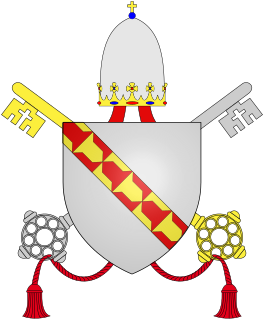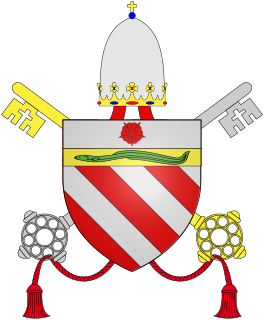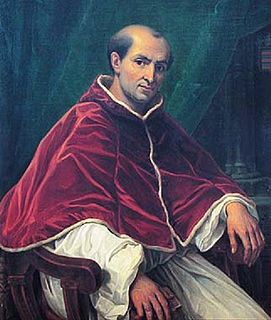Related Research Articles

Orsini is an Italian noble family that was one of the most influential princely families in medieval Italy and Renaissance Rome. Members of the Orsini family include three popes: Celestine III (1191–1198), Nicholas III (1277–1280), and Benedict XIII (1724–1730). In addition, the family included 34 cardinals, numerous condottieri, and other significant political and religious figures.

Pope Martin IV, born Simon de Brion, was the head of the Catholic Church and ruler of the Papal States from 22 February 1281 to his death. He was the last French pope to have held court in Rome; all subsequent French popes held court in Avignon.

Pope Celestine IV, born Goffredo da Castiglione, was Bishop of Rome and as such head of the Catholic Church and ruler of the Papal States for only a few days from 25 October 1241 to his death.

Pope John XXII, born Jacques Duèze, was head of the Catholic Church from 7 August 1316 to his death in 1334.

Nicholas V, born Pietro Rainalducci was an antipope in Italy from 12 May 1328 to 25 July 1330 during the pontificate of Pope John XXII (1316–1334) at Avignon. He was the last antipope set up by a Holy Roman Emperor.

Pope Nicholas III, born Giovanni Gaetano Orsini, was head of the Catholic Church and ruler of the Papal States from 25 November 1277 to his death.
Blessed Margherita Colonna, was a member of the Italian Colonna family, which was notable in Italian history for centuries. She lived as a nun, with her followers.
Pietro Colonna was an Italian cardinal.
Orsini is a surname of Italian origin, ultimately derived from Latin ursinus ("bearlike") and originating as an epithet or sobriquet describing the name-bearer's purported strength. Notable people with the surname include the following:

Matteo Orsini was an Italian Dominican friar and Cardinal.
Giovanni Boccamazza was an Italian Cardinal. He was from the Roman nobility, and was a nephew of Cardinal Giacomo Savelli, who had been an important figure in the Roman Curia since his creation as cardinal in 1261.

Latino Malabranca Orsini was a Roman noble, an Italian cardinal of the Holy Roman Church, and nephew of Pope Nicholas III.
Giovanni Battista Savelli was an Italian cardinal from the 15th century. Of the noble Savelli family to which belonged Pope Honorius III (1216–1227) and Pope Honorius IV (1285–1287) and Cardinals: Bertrando Savelli, Silvio Savelli, Giulio Savelli, Fabrizio Savelli, Paolo Savelli and Domenico Savelli. He was called the Cardinal Savelli.

The 1314–16 papal conclave, held in the apostolic palace of Carpentras and then the Dominican house in Lyon, was one of the longest conclaves in the history of the Roman Catholic Church and the first conclave of the Avignon Papacy. The length of the conclave was due to the division of the cardinals into three factions: Italian, Gascon, and French/Provençal.

The 1304–1305 papal conclave, held in Perugia, was the protracted papal conclave that elected non-cardinal Raymond Bertrand de Got as Pope Clement V. This immediately preceded the beginning of the Avignon Papacy.
Napoleone Orsini was a Roman Cardinal. His ecclesiastical career lasted 57 years, 54 of them as a cardinal, and included six conclaves.
Giovanni Colonna was a Roman Catholic cardinal during the Avignon papacy and was a scion of the famous Colonna family that played an important role in Italian history.

Matteo Rosso Orsini, was a Roman aristocrat, politician, diplomat, and Roman Catholic Cardinal. He was the nephew of Pope Nicholas III (1277-1280).

Bertrand de Déaulx was a French bishop, diplomat and Cardinal. He was born, perhaps around 1290, in Castrum de Blandiaco in the diocese of Uzès; or in Déaulx. He died in Avignon in 1355. Trained as a lawyer and teacher of law, he practiced in the papal courts, and became an arbitrator and diplomat for the Papacy. He had several assignments in Italy and one in Catalonia. He was responsible for the reorganization of the University of Montpellier and the granting of revised charters.
Rolando de' Rossi was an Italian nobleman and statesman. He was the dominant force in the politics of the commune of Parma from 1322 until 1335, effectively as signore between 1328 and 1331. Under him and his brother, between 1331 and 1333, the city accepted the lordship of the King of Bohemia. Ultimately, the failure of his family's political project brought an end Parmesan autonomy. In his later years he was a condottiero for Venice and Florence.
References
- 1 2 3 4 5 6 7 ORSINI, Giovanni Gaetano (ca. 1285-1335) at fiu.edu, accessed 5 December 2010
- ↑ Blake R. Beattie, Angelus pacis: the legation of Cardinal Giovanni Gaetano Orsini, 1326-1334 (2006), p. 41
- 1 2 Beattie, op. cit., p. 139
- ↑ ORSINI, Giovanni Gaetano (ca. 1210/1220-1280) at fiu.edu, accessed 5 December 2010
- ↑ Beattie, op. cit., p. 195
- 1 2 Christopher Kleinhenz, Medieval Italy: an encyclopedia, vol. 1 (2004), p. 588
- ↑ Anthony Kimber Cassell, The Monarchia controversy: an historical study with accompanying translations (2004), p. 35
- ↑ Beattie, op. cit., pp. 117-118
- ↑ Ronald G. Musto, Apocalypse in Rome: Cola di Rienzo and the politics of the New Age (University of California Press, 2003), p. 152
- ↑ Conclave of October 21 - 22, 1303 at fiu.edu, accessed 5 December 2010
- ↑ H. K. Mann, Tombs and Portraits of the Popes of the Middle Ages (2003 reprint), p. 128